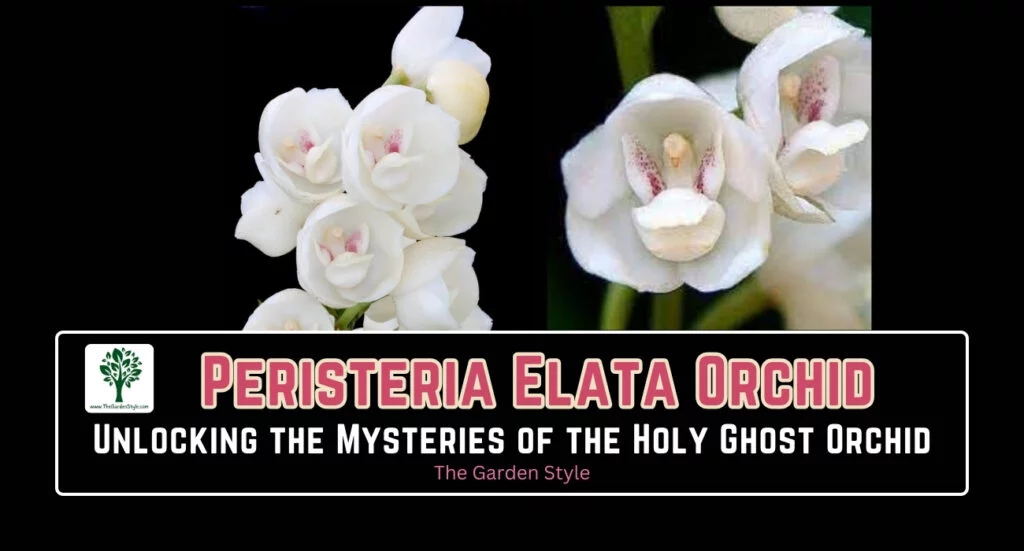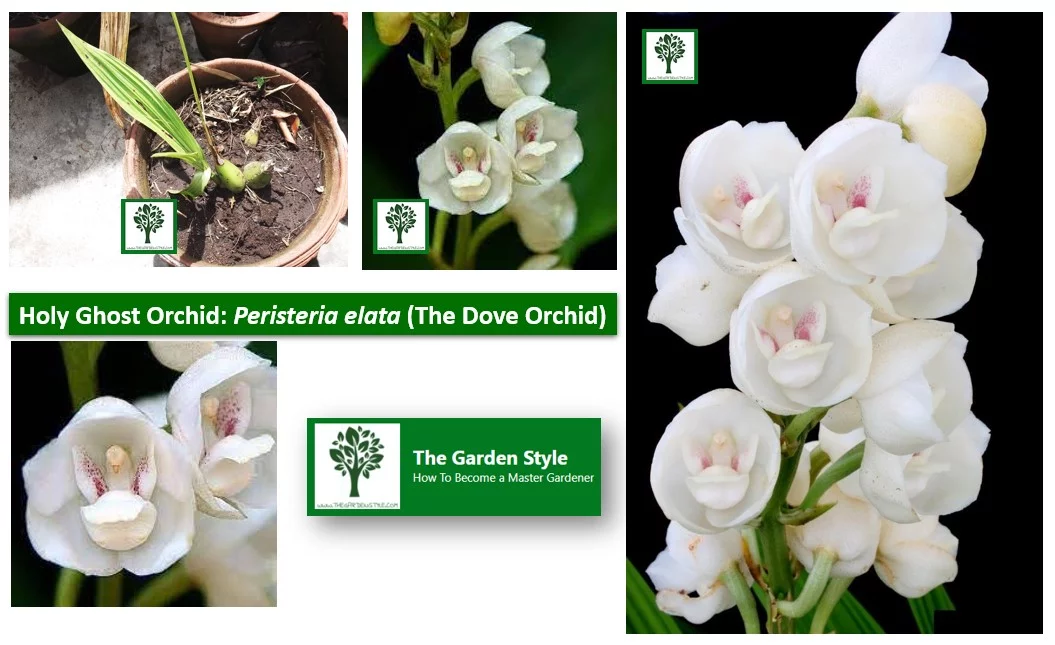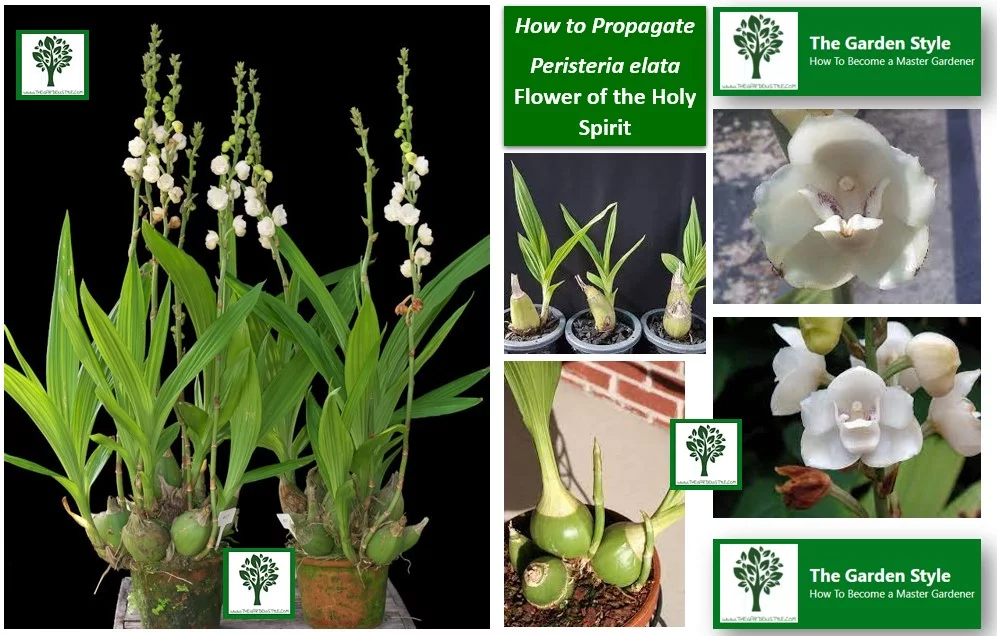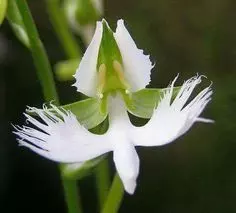Table of Contents
The Orchid Dove Peristeria elata Flower of the Holy Spirit: Care and Cultivation
Peristeria elata, the national flower of Panama, also known as the flower of the Holy Spirit, is an orchid. Why is it called the flower of the Holy Spirit? The Peristeria elata resembles a white dove, belongs to the orchid genus Peristeria, and is characterized by its intense ivory-colored petals and blooms at Easter time. Let’s start with How to Grow Flower of the Holy Spirit.
Although its origin is Panama, it also blooms in other areas, such as Colombia or Peru. Its ideal habitat is an extremely humid forest, as it usually blooms in mosses on tree trunks.
What is Panama’s National Flower
Anecdotally, the Peristeria elata orchid was declared the National Flower of Panama in 1980, and such is the symbolism of this orchid variety that every year in September, it is honored with an exhibition bearing its name, the Expoferia del “Espíritu Santo”, meaning exhibition of “the Holy Spirit”.

Flower of the Holy Spirit: Genus Peristeria
Flower of the Holy Spirit. The genus Peristeria comes from the Greek word ‘peristerion‘ meaning dove, due to the striking resemblance of the flowers (column, anther, and lateral lobes of the lip), – especially its type species – to a small dove in flight.
A spectacular species, its leaves and flowering stem can reach a meter or more. The flowers are colorful and fragrant and have a lip with purple spots. The flower resembles a pigeon in its nest, which is why it is called the orchid pigeon.
The Flower of the Holy Spirit or Peristeria elata orchid is in danger of extinction, to the point that technicians in Taiwan a few years ago developed a recovery program to achieve its recovery, while authorities are trying to ensure that it is used only for exhibitions and not sold.
According to experts, Cerro Gaital in the Anton Valley, about 62 miles (100 kilometers) from the capital, is the main habitat of Panama’s national flower.
Peristeria elata habitat is the very moist, mature montane forest, where it is found in mosses on trees at about 3,600 ft (1,100 meters) above sea level but close to the ground.
The Peristeria elata orchid is so delicate that it cannot be watered with drinking water, as it contains chlorine, but only with rainwater.

How to Grow Peristeria elata – Care Guide
Grow Flower of the Holy Spirit. It is not easy to cultivate and grow Peristeria elata successfully, especially if the climate is not suitable.
I have been cultivating this species for several years, during which time I have observed two essential aspects that make it bloom.
In the following paragraphs, you will find our advice on How to care for Peristeria elata and grow the Dove orchid from seeds.
Firstly, it is not to overcome humidity when the new pseudobulbs are maturing. Secondly, it is to guarantee plenty of filtered light, perhaps by moving the plant outdoors in ventilated and semi-shaded spaces during the pre-flowering phase (spring-summer).
Soil for Peristeria elata Flower of the Holy Spirit.
Soil for Peristeria elata. The substrate should be airy, rich in organic material, acidic, and kept at a constant, but not excessive, humidity.
Peristeria elata orchid grows very well in soils rich in organic material and ventilated between small shrubs on slopes, while it does not like shady environments in dense, century-old forests.

Climate and Watering for Growing Peristeria elata
In the following paragraphs, let’s review the Climate and Watering for Growing Peristeria elata Flower of the Holy Spirit.
For successful cultivation, the plant should be kept in a moist environment, the potting substrate should have good drainage, and it should be watered regularly with non-chlorinated water and possibly rainwater.
Peristeria elata orchid does not have many bacterial and/or fungal enemies. The most vulnerable parts are the turgid pseudobulbs, on which excessive humidity and stagnant water between the thin sheaths cause rotting spots with unusual speed and violence. These spots become vehicles for the spread of bacteria and fungi, sometimes with fatal results for the plants.
In nature, the Peristeria elata orchid is subject to the monsoon climate, characterized by a rainy and drier phase; this should also be reproduced in cultivation, reducing irrigation when vegetative rest intervenes.
- Fertilizations of the Peristeria elata orchid can be given fortnightly during the development period and halved during the dry phase.
- Origin: South America
- Climate: Temperate to temperate/hot
- Temperature: 59 to 86 °F (15 to 30°C)
- Light: Strong, can be placed in front of a window, but protected by a veil, not exposed to direct sun
- Watering: Regularly, the soil must never dry out.
- Flowering period: Summer
- Soil: Mixture of sphagnum moss and dust-free pine bark of medium particle size.
How to Propagate Peristeria elata – Pollination of Peristeria elata Orchid Flower of the Holy Spirit.
In the following paragraphs, you will find our advice on How to Propagate Peristeria elata and how to make seedlings.
In this chapter, besides taking note of the methods of natural pollination by pollinating insects, we will follow in sequence the operations of artificial pollination of a Peristeria elata flower.

Discover the beauty and how to grow Pecteilis radiata: The White Egret Orchid in my recent article.
For many years there has been only one plant of Peristeria elata in my collection.
Due to its rarity, those who can reproduce it from seed may find artificial pollination helpful.
In nature, the flowering period includes the months of July, August, September, and October, during which the flowers of Peristeria elata are pollinated by orchid bees (euglossine), specifically by males.
The males, attracted by the scent of the flowers, seek the chemical that attracts the females.
Pollination of Peristeria elata by Euglossins
The term “euglossine pollination” is used when orchid flowers are visited only by male bees of the euglossine group.
This “means” of pollination involves at least four genera of euglossine bees and is used by several orchid genera, as well as some genera of Araceae and Gesneriaceae.
Among orchids, these pollination systems have allowed the development of unusual physical pollination mechanisms.
In some cases, the pollinarium is forcibly ejected by the orchid toward the pollinating insect “Catasetum for example”, in other cases, the bees are forced into predetermined slimy paths that force them to fall right on top of the pollinarium. The arrangement of the bee within the flower and the positioning of the pollinarium on the bee are often very precise, and in addition, the scent of the flower is intended to attract, in many cases, a single species of bee.
Safeguarding the Purity of the Peristeria elata Orchid
These examples show how precise and, at the same time, how refined the correlation between the pollinating insect and the flower to be visited is to safeguard the purity of plant species, which, although similar (and thus hybridizable), manage to remain pure precisely because of this high degree of selectivity.
Sudden environmental changes and the movement of species by dispersal can alter and accelerate the normal slow morphological changes.
Orchid Pollinating Bees
Orchid-pollinating bees belong to the corbiculate group, of which all members are parasitic and have no “eusocial” behavior—social hierarchy. Most species are solitary, and only a few live in communities with some semblance of eusociality.
There are about 200 described species distributed in five genera: Euglossa, Eulaema, Eufriesea, Exaerete, and Aglae. All are found in Central and South America. All genera except Eulaema are characterized by their bright metallic coloring, especially green, with gold and dark blue highlights.
We hope you enjoyed our article on growing Peristeria elata, the Holy Spirit Orchid—Easter Dove Orchid Cultivation—Flower of the Holy Spirit Care Guide. Here is a video to enjoy with the Flower of the Holy Spirit.
Are you an Orchids Lover? Here are Orchid’s Articles recommended for you:
Orchids of Costa Rica – The Most Complete Guide
Monkey Face Orchid – Most Complete Guide
How to Prune Orchids – Step-by-Step Guide
Learn more about How to Propagate an Orchid.

